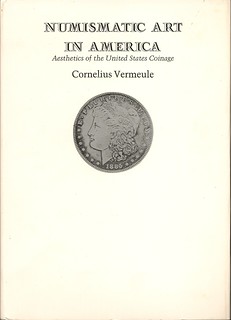
PREV ARTICLE
NEXT ARTICLE
FULL ISSUE
PREV FULL ISSUE
CORNELIUS CLARKSON VERMEULE III (1925-2008)E-Sylum Feature Writer and American Numismatic Biographies author Pete Smith submitted this article on author Cornelius Vermeule. Thanks! -Editor
Cornelius Clarkson Vermeule III (1925-2008)
He was born in South Orange, New Jersey, on August 10, 1925. His father, Cornelius Vermeule II (1895-1943) was distinguished as a major during the first world war and served as Director of Public Works Administration in New Jersey. His Mother was Catherine Sayre Comstock (1894-1996). While in England in 1934, he began to collect ancient coins. Both his father and grandfather collected coins and their collections were passed down to him. Before going to college, Vermeule worked at Stack's on 57th Street in New York He was not paid in cash but in ancient Roman coins. Vermeule entered Harvard in 1943 but his education was interrupted with service in the Army during the war. He studied Japanese and stayed in Japan for a while after the war ended and attained the rank of Captain. Back at Harvard, he received an A.B. in 1949 and M.A. in 1951. He received a Ph.D. from the University of London in 1953. While in London he assembled much of his collection of Roman Imperial bronze coins. The American Numismatic Society in New York City attempted to promote young numismatic scholars. In 1951 they offered a $100 prize for the best paper on numismatics. The winner was Cornelius Clarkson Vermeule III.
He collaborated with Norman Jacobs to write Japanese Coinage in 1953. It was published by Stack's Numismatic Review. It was followed by His first professional job was teaching fine arts at the University of Michigan from 1953 to 1955. Then he was professor of archaeology at Bryn Mawr College until 1957. Cornelius married Emily Dickinson Townsend (1928-2001) on February 2, 1957. She had been a Bryn Mawr student who graduated summa cum laude in 1950, received a masters degree from Radcliff in 1954 and returned to Bryn Mawr for her Ph.D. in 1956. She was later a professor at Harvard. The couple enjoyed going on archeological digs together. Their daughter Emily Dickinson Blake Vermeule. is a professor of English at Stanford University. Their son, Adrian Vermeule, is a professor at Harvard Law School. Also in 1957, Vermeule contributed to the coin room at Harvard's Fogg Museum. The museum may be remembered for an armed robbery of 3000 coins in 1973. It was described at the time as the largest coin theft in American history. Later in 1957 Cornelius was appointed curator of classical collections at the Museum of Fine Arts on Huntington Avenue in Boston. He arranged for the acquisition of two large Greek vases from the fifth century BCE portraying the fall of Troy and the death of Agamemnon. When director Rathbone was forced to resign because of the acquisition of a stolen Raphael, Vermeule served as acting director of the museum. Late in his career he was also involved in the acquisition without documentation of possibly looted antiquities. He retired in 1996. He wrote Numismatic Art in America: Aesthetics of the United States Coinage in 1971. It grew out of a series of lectures Vermeule made a few years earlier. A second edition published in 2007 describes more recent coins including the state quarters. Vermeule was known as a prankster and joker in several languages. He brought his dalmatians, named after classical Romans to work. Along that theme of dalmatians, he wore white shoes painted with black dots around the museum. He described them as the only pieces of modern art to appear in all rooms of the museum.
Vermeule's collection of roman coins was offered in a mail bid sale by Classical Numismatic Group on June 23, 1999. It was sold for the benefit of the classical department of the Boston Museum of Fine Arts. His Roman Imperial Republican and Imperatorial Gold were included in the Triton III sale of November 30 and December 1, 1999. Stack's published a catalog for the sale of his remaining collection at auction on September 11, 2001. The sale was postponed until November 12-13. The write up for Vermeule included some useful biographical information with a fair amount of hype for the auction company. Vermeule was a lifetime fellow at the American Numismatic Society, served on the council and served on committees. He died following a stroke at Mount Auburn Hospital in Cambridge, Massachusetts, on November 27, 2008.
I did not mention Vermeule in a recent article I wrote about
Comment
This was a frustrating article to research. I spent more hours looking for what I could not find than hours that were productive. I wanted to know the connection between Emily Dickinson Townsend and the poet Emily Dickinson. I could not find a common ancestor. I also read that Anna Hyatt Huntington was the great step-aunt of Vermeule. I could not make that connection.
Teaser
If I can find the time next week, I want to write about the most wealthy American woman in the Gilded Age.
For more information on Huntington's
To read earlier E-Sylum articles, see:
Wayne Homren, Editor The Numismatic Bibliomania Society is a non-profit organization promoting numismatic literature. See our web site at coinbooks.org. To submit items for publication in The E-Sylum, write to the Editor at this address: whomren@gmail.com To subscribe go to: https://my.binhost.com/lists/listinfo/esylum All Rights Reserved. NBS Home Page Contact the NBS webmaster 
|




